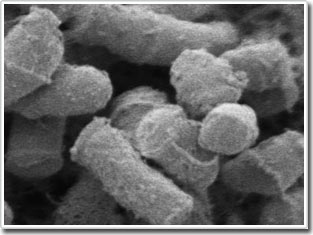The survival war of bacteria creates new antibiotics
MIT biologists have recently caused the underground bacteria to produce a new antibiotic by taking them into a survival war with another bacterium. This antibiotic promises promise in the treatment of Helicobacter pylori bacteria that causes stomach ulcers in humans. Besides, once the answer is found on how to make antibiotics, scientists can develop strategies to find other antibiotics.
The study was published in the February issue of The American Chemical Society .
According to Philip Lessart, a scientist at Professor Anthony Sinskey's lab at MIT, the discovery of new antibiotics is a result of luck, patience and effort in research.

Rhodococcus bacterial cells (Photo: MIT)
Professor Sinskey's lab conducted research with Rhodococcus - a bacterium that resides in rocky soil - for many years. In the process of sequencing the genome of Rhodococcus, they found a large number of genes that seem to encode secondary metabolic products. These are compounds like antibiotics, toxins and pigments.
However, Rhodococcus bacteria often do not produce antibiotics. Many types of bacteria have genes that generate antibiotics but are only activated when the bacteria is threatened. Therefore, researchers believe that this situation may also be true for Rhodococcus bacteria.
Kazuhiko Kurosawa, a postdoctoral researcher in the Department of Biology, tried to force bacteria to synthesize antibiotics by placing them in threatened environments. He tried increasing the temperature, then changing the growth environment of bacteria but no results.
Kurosawa decided to put pressure on Rhodococcus bacteria by forcing them to grow in the presence of a competitive bacterium - Streptomyces strain. Streptomyces often synthesize antibiotics that can kill other bacteria. But in one of the test tubes, Rhodococcus produced its own antibiotic and wiped out the Streptomyces.
Scientists who took this antibiotic named rhodostreptomycin then began testing its efficacy for other bacteria. It has a positive effect on many strains of bacteria, notably Helicobacter pylori. Rhodostreptomycin is a promising remedy for the treatment of H. pylori because it is still effective even in an acidic environment such as the stomach.
In fact, the above antibiotic is a compound called aminoglycoside that includes special sugar molecules, one of which has a previously undiscovered circle structure. The circular structure makes chemists a target for change, allowing them to synthesize antibiotics more efficiently and more stable.
Lessard said: 'Even if rhodostreptomycin is not the most effective drug, it also provides new structures for chemical derivatives. This may be a starting point for future generation antibiotics. A mystery yet to be answered is why Rhodococcus bacteria synthesize antibiotics . Some scientists argue that the very presence of competing strains causes Rhodococcus to be put on alert and activate new genes.

Scientists Philip Lessard , Kazuhiko Kurosawa and Anthony Sinskey introduced a new antibiotic created by two competing bacteria. (Photo: MIT)
The new Rhodococcus strain can synthesize antibiotics with megaplasmid - this is an additional DNA fragment of relatively large size taken from the Streptomyces strain. The reasonable conclusion is that plasmids carry the rhodostreptomycin synthesis gene, but the researchers analyzed half the plasmid sequence and found no genes related to antibiotics.
Another theory is that the plasmid itself acts as a damaging agent that causes Rhodococcus bacteria to synthesize antibiotics. Thus, the interaction between two bacterial genomes can create new antibiotics.
Lessard said: 'Somehow the genes in megaplasmid have been combined with the genes of Rhodococcus and together they have created a product that none of these particular species produce when not present in the species. that'.
If scientists know how this happens, they can start working on manipulating the bacterial genome with a method to make new antibiotics.
Other authors of the research paper include: TG Sambandan - a scientist at MIT's Department of Biology, biology professor Anthony Sinskey and professor Chokyun Rha majoring in biomaterials, engineering laboratory (MIT ), Ion Ghiviriga and Joanna Barbara of Florida University.
- What are antibiotics and classify antibiotics
- Bad habits of parents hurt the liver and kidneys, endanger children
- Bacteria resistant to two types of prophylactic antibiotics have been found in the United States
- The last defensive layer before the virus takes us back to the Stone Age
- Pharmaceutical originated from the sea
- The world is depleted of new generation antibiotics
- Find the gene that causes bacteria to disable antibiotics
- When antibiotics become useless, more people die from bacteria than cancer
- 'Heavenly' facts about antibiotics
- Is it not necessary to take an adequate dose of antibiotics?
- How did bacteria learn to fight antibiotics?
- Find new antibiotics under the ocean
 Green tea cleans teeth better than mouthwash?
Green tea cleans teeth better than mouthwash? Death kiss: This is why you should not let anyone kiss your baby's lips
Death kiss: This is why you should not let anyone kiss your baby's lips What is salmonellosis?
What is salmonellosis? Caution should be exercised when using aloe vera through eating and drinking
Caution should be exercised when using aloe vera through eating and drinking